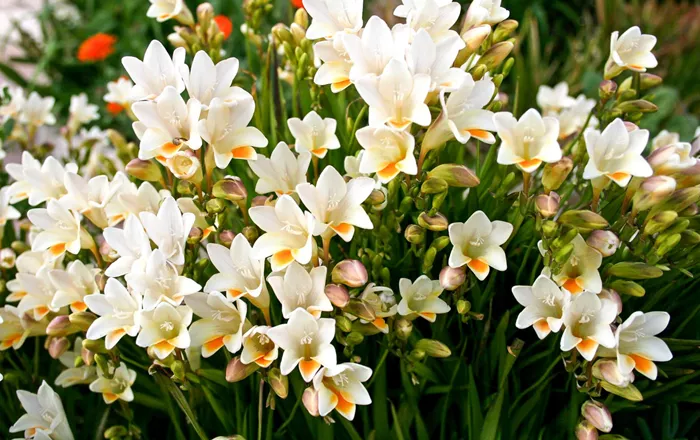Freesias are vibrant, fragrant flowers that can add a burst of color to any garden. The timing of planting Freesia bulbs is crucial for achieving healthy blooms. Knowing when to plant these bulbs can make all the difference in the success of your garden. This guide will explore the best month to plant Freesia bulbs, ensuring you get the most out of these beautiful flowers.
Understanding Freesia
Origins and Characteristics of Freesia
Freesias are native to South Africa and are known for their striking colors and delightful scent. These flowers belong to the Iridaceae family and come in a range of hues, including red, purple, white, and yellow. Freesias are popular in both flower beds and containers.
Types of Freesia Bulbs
Freesia bulbs come in several varieties, each with unique flowering times and growth requirements. Common types include hybrid varieties and species-specific ones. Understanding the type of Freesia you are planting can help you decide the ideal planting time.
The Climate Consideration
Understanding the Growth Conditions
Freesias thrive in a moderate climate, ideally between 60-70°F (15-21°C). Extreme cold or heat can hinder their growth. Planting Freesia bulbs at the right time, considering your region’s climate, will yield better results.
Regions Best Suited for Freesia Growth
Freesias do best in areas with mild winters and moderate summers. In colder climates, Freesia bulbs can be planted indoors or in pots, allowing the bulbs to grow in controlled conditions. In warmer regions, Freesias can be planted directly into the ground during the appropriate planting season.
The best Ideal Month to Plant Freesia Bulbs
Spring Planting: The Best Option
The best month to plant Freesia bulbs is typically in early spring, from March to April. This timing aligns with the end of the frost season, giving the bulbs enough warmth to sprout and grow without the risk of being damaged by late freezes.
Planting Time in Different Regions
In regions with warmer winters, Freesia bulbs can be planted as early as January or February, provided there is no risk of frost. In cooler climates, it is recommended to wait until the ground has warmed up in March or April.
Preparing the Soil for Planting
Soil Type and Drainage
Freesias require well-draining soil to avoid waterlogging. Loamy or sandy soil is ideal, as it allows water to pass through without causing root rot. If your soil is too heavy, consider adding organic matter like compost to improve its texture.
pH Level
Freesias prefer slightly acidic to neutral soil, with a pH between 6.0 and 7.0. Conduct a soil test to ensure the pH level is optimal for growth. If the soil is too acidic or alkaline, amend it to create the perfect environment for your bulbs.
Planting Freesia Bulbs
Choosing the Right Depth
When planting Freesia bulbs, dig a hole about 2 to 3 inches deep. Place the bulb with the pointed end facing up. Ensure that the bulbs are spaced 4 to 6 inches apart to allow for proper air circulation and growth.
Watering and Fertilization
Water the bulbs immediately after planting, but avoid soaking the soil. Freesias do not like to sit in overly wet soil. Once the bulbs are planted, water them regularly to keep the soil moist but not waterlogged. Adding a balanced fertilizer every 4-6 weeks will encourage healthy growth.
Caring for Freesia After Planting
Sunlight Requirements
Freesias prefer full sunlight or partial shade. Ensure that they receive at least 6 hours of sunlight each day for optimal growth. If you are planting Freesias in pots, consider moving them to a sunny spot throughout the day.
Temperature Considerations
Freesias thrive in temperatures between 60°F and 70°F. If the weather turns too hot, consider providing some shade to prevent the flowers from wilting. In cooler climates, consider using row covers or growing Freesias in containers that can be moved to warmer locations.
Common Issues and Solutions
Pests and Diseases
Common pests like aphids and thrips can affect Freesia plants. Regularly inspect your plants for signs of pests and treat them with organic insecticides if necessary. Freesias are also susceptible to fungal diseases, so avoid overhead watering to keep the foliage dry.
Troubleshooting Growth Problems
If your Freesias are not growing well, check for issues with the soil drainage, sunlight, and temperature. Freesias may also fail to bloom if they are planted too early or too late, so ensure you follow the ideal planting schedule for your region.
Harvesting and Storing Freesia Bulbs
When to Harvest Freesia Bulbs
Freesia bulbs should be harvested after the flowering season ends. This typically occurs in late spring or early summer. Carefully dig up the bulbs once the flowers have faded and the foliage has begun to yellow.
Storing Bulbs for the Next Season
After harvesting, clean the bulbs and let them dry for a few days. Store them in a cool, dry place until the next planting season. It is essential to keep the bulbs in a place with good ventilation to prevent mold and rot.
Conclusion
Planting Freesia bulbs at the right time is essential for achieving beautiful, vibrant flowers. By considering the climate, soil, and the specific needs of your Freesias, you can enjoy these lovely blooms year after year. Remember, early spring is typically the best time to plant these bulbs, but adjusting according to your region’s weather can also yield great results. Happy gardening!


